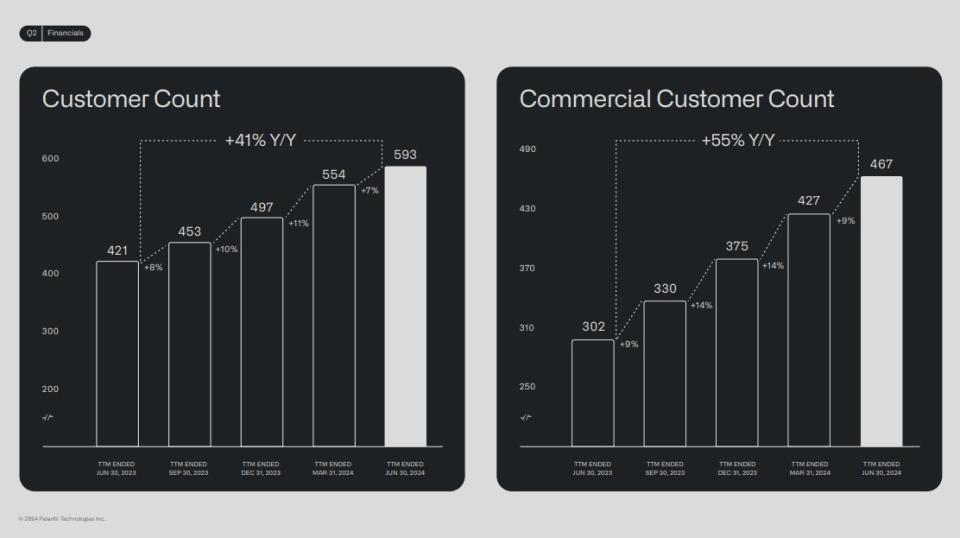Remember when blockchain technology, the metaverse, and SPACs all seemed poised to be the “next big things” in investing? The hype (and the stock prices) in those cases may have gotten a bit ahead of themselves.
Perhaps in part as a result, in recent years, those who follow the technology sector have put extra scrutiny on companies claiming that they’re poised to benefit from opportunities in artificial intelligence (AI). And I get it. Any time there’s even the slightest hint of a megatrend getting underway, it’s inevitable that some companies will try to climb on board, even if their connections to it are tenuous. I’m looking at you, Long Island Iced Tea Corp. — or should I say, Long Blockchain Corp.?
For a while now, one particular company with aspirations in the AI space has been at the center of many bearish narratives. Yet despite this, it has continued to make a name for itself. Now, it’s joining one of the most exclusive clubs in the business world: the S&P 500.
Let’s explore how a once-niche software developer has taken on big tech and emerged as a rising star in the AI arena.
It was labeled an AI imposter
In June 2023, an online publisher of short reports called The Bear Cave labeled a particular software company as an “AI imposter.” The Bear Cave went on to proclaim that it was simply a “glorified consultant masquerading as an AI leader.”
So while the company in question was promoting itself as an enterprise software specialist, there was more than a kernel of skepticism revolving around such a narrative, and with that came conflicting views over the company’s prospects as an investment. In fact, its shares were only $14 last June — less than half of what they trade for today.
There is a world of difference between a high-margin software enterprise and a consulting operation such as Booz Allen Hamilton or Accenture.

Bears thought it was too reliant on government business
Another big piece of the bear argument was that this AI company relied too much on defense deals with the U.S. military and intelligence agencies, and those of our Western allies. Considering the company does in fact have an influential presence in the public sector, that narrative wasn’t entirely misplaced.
To be clear, being a government contractor is not a bad business, per se. However, the deal flows and opportunities originating from the public sector tend to be much lumpier than those from the private sector.
Relying too much on government business can make forecasting revenue and cash flow difficult. For this reason, some investors were questioning the long-run viability of the business.
Next stop? The S&P 500
All right, that’s enough of a preview. The company that has been called an AI imposter and a mere consulting operation for the government is Palantir Technologies (NYSE: PLTR).
Palantir has three primary software platforms: Foundry, Gotham, and Apollo. All three carry various data analytics capabilities and are used across a host of use cases including supply chain logistics and financial fraud.
It wasn’t until April 2023 that the narrative around Palantir started to shift. The company released its fourth flagship development — the Palantir Artificial Intelligence Platform (AIP). While seeing innovation come out of a small enterprise is encouraging, Palantir had a problem: It was being completely overshadowed by big tech “Magnificent Seven” members such as Microsoft (which invested in ChatGPT maker OpenAI), and Amazon and Alphabet (both of which invested in AI start-up Anthropic).
How could Palantir possibly prove that it was a real player in AI software?
Palantir adopted a creative lead-generation strategy through which prospective customers could demo the AIP platform by testing it on one of their own unique use cases. These AIP “boot camps” helped bolster Palantir’s deal pipeline as businesses started to realize the power of AIP and develop use cases revolving around artificial intelligence.
These moves are paying off in more ways than one. Since the release of AIP, Palantir has witnessed a noticeable surge in demand from the private sector. This has helped diversify its revenue stream, tempering some of the concerns about it being too reliant on public sector deal flow.


Moreover, penetrating the commercial sector has helped ignite an acceleration in Palantir’s revenue. When combined with the company’s low-cost approach to marketing featuring the boot camps, Palantir has been able to achieve strong unit economics overall. Expanding operating margins and rising profits have been a hallmark of its financial profile for some time now.
By the basic criteria, Palantir has been eligible for S&P 500 inclusion for several quarters. But even the advent of AIP and the impact it has had on the business was not, at first, enough to earn the company a spot in the index. Palantir bears asserted that the company’s share price might be benefiting from the AI boom and that its current growth trajectory wasn’t sustainable.
Well, these arguments might finally be silenced. Last week, investors learned that Palantir had been chosen for inclusion into the index and will officially begin trading as a member of the S&P 500 on Sept. 23.
Furthermore, with more big tech stalwarts such as Microsoft and Oracle partnering with Palantir, I’m optimistic that the company’s long-term prospects across both the public and private sectors will continue to blossom. Overall, I see Palantir as a compelling investment for those with long investing horizons, and think its induction into the S&P 500 is far from its last milestone achievement.
Should you invest $1,000 in Palantir Technologies right now?
Before you buy stock in Palantir Technologies, consider this:
The Motley Fool Stock Advisor analyst team just identified what they believe are the 10 best stocks for investors to buy now… and Palantir Technologies wasn’t one of them. The 10 stocks that made the cut could produce monster returns in the coming years.
Consider when Nvidia made this list on April 15, 2005… if you invested $1,000 at the time of our recommendation, you’d have $662,392!*
Stock Advisor provides investors with an easy-to-follow blueprint for success, including guidance on building a portfolio, regular updates from analysts, and two new stock picks each month. The Stock Advisor service has more than quadrupled the return of S&P 500 since 2002*.
*Stock Advisor returns as of September 9, 2024
John Mackey, former CEO of Whole Foods Market, an Amazon subsidiary, is a member of The Motley Fool’s board of directors. Suzanne Frey, an executive at Alphabet, is a member of The Motley Fool’s board of directors. Adam Spatacco has positions in Alphabet, Amazon, Microsoft, and Palantir Technologies. The Motley Fool has positions in and recommends Accenture Plc, Alphabet, Amazon, Microsoft, Oracle, and Palantir Technologies. The Motley Fool recommends Booz Allen Hamilton and recommends the following options: long January 2025 $290 calls on Accenture Plc, long January 2026 $395 calls on Microsoft, short January 2025 $310 calls on Accenture Plc, and short January 2026 $405 calls on Microsoft. The Motley Fool has a disclosure policy.
This Artificial Intelligence (AI) Stock Was Labeled an “AI Imposter” and Written Off as No More Than a Government Contractor. Now It’s Joining the S&P 500 and Shares Are Soaring. was originally published by The Motley Fool
Source Agencies

